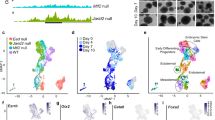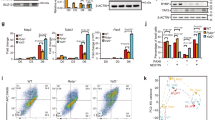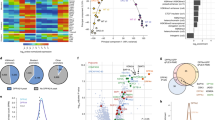Abstract
Polycomb Repressor Complexes (PRCs) are important regulators of embryogenesis. In embryonic stem (ES) cells many genes that regulate subsequent stages in development are enriched at their promoters for PRC1, PRC2 and Ser 5-phosphorylated RNA Polymerase II (RNAP), and contain domains of 'bivalent' chromatin (enriched for H3K4me3; histone H3 di- or trimethylated at Lys 4 and H3K27me3; histone H3 trimethylated at Lys 27). Loss of individual PRC components in ES cells can lead to gene de-repression and to unscheduled differentiation. Here we show that Jarid2 is a novel subunit of PRC2 that is required for the co-recruitment of PRC1 and RNAP to genes that regulate development in ES cells. Jarid2-deficient ES cells showed reduced H3K4me2/me3 and H3K27me3 marking and PRC1/PRC2 recruitment, and did not efficiently establish Ser 5-phosporylated RNAP at target genes. ES cells lacking Jarid2, in contrast to previously characterized PRC1 and PRC2 mutants, did not inappropriately express PRC2 target genes. Instead, they show a severely compromised capacity for successful differentiation towards neural or mesodermal fates and failed to correctly initiate lineage-specific gene expression in vitro. Collectively, these data indicate that transcriptional priming of bivalent genes in pluripotent ES cells is Jarid2-dependent, and suggests that priming is critical for subsequent multi-lineage differentiation.
This is a preview of subscription content, access via your institution
Access options
Subscribe to this journal
Receive 12 print issues and online access
$209.00 per year
only $17.42 per issue
Buy this article
- Purchase on Springer Link
- Instant access to full article PDF
Prices may be subject to local taxes which are calculated during checkout





Similar content being viewed by others
Accession codes
References
Bernstein, B. E. et al. A bivalent chromatin structure marks key developmental genes in embryonic stem cells. Cell 125, 315–326 (2006).
Boyer, L. A. et al. Polycomb complexes repress developmental regulators in murine embryonic stem cells. Nature 441, 349–353 (2006).
Lee, T. I. et al. Control of developmental regulators by Polycomb in human embryonic stem cells. Cell 125, 301–313 (2006).
Azuara, V. et al. Chromatin signatures of pluripotent cell lines. Nat. Cell Biol. 8, 532–538 (2006).
Jaenisch, R. & Young, R. Stem cells, the molecular circuitry of pluripotency and nuclear reprogramming. Cell 132, 567–582 (2008).
Jorgensen, H. F. et al. Stem cells primed for action: polycomb repressive complexes restrain the expression of lineage-specific regulators in embryonic stem cells. Cell Cycle 5, 1411–1414 (2006).
Buszczak, M. & Spradling, A. C. Searching chromatin for stem cell identity. Cell 125, 233–236 (2006).
Stock, J. K. et al. Ring1-mediated ubiquitination of H2A restrains poised RNA polymerase II at bivalent genes in mouse ES cells. Nat. Cell Biol. 9, 1428–1435 (2007).
Guenther, M. G., Levine, S. S., Boyer, L. A., Jaenisch, R. & Young, R. A. A chromatin landmark and transcription initiation at most promoters in human cells. Cell 130, 77–88 (2007).
Dellino, G. I. et al. Polycomb silencing blocks transcription initiation. Mol. Cell. 13, 887–893 (2004).
Pasini, D., Bracken, A. P., Hansen, J. B., Capillo, M. & Helin, K. The polycomb group protein Suz12 is required for embryonic stem cell differentiation. Mol. Cell Biol. 27, 3769–3779 (2007).
Endoh, M. et al. Polycomb group proteins Ring1A/B are functionally linked to the core transcriptional regulatory circuitry to maintain ES cell identity. Development 135, 1513–1524 (2008).
Shen, X. et al. EZH1 mediates methylation on histone H3 lysine 27 and complements EZH2 in maintaining stem cell identity and executing pluripotency. Mol. Cell 32, 491–502 (2008).
Faust, C., Schumacher, A., Holdener, B. & Magnuson, T. The eed mutation disrupts anterior mesoderm production in mice. Development 121, 273–285 (1995).
O'Carroll, D. et al. The polycomb-group gene Ezh2 is required for early mouse development. Mol. Cell Biol. 21, 4330–4336 (2001).
Voncken, J. W. et al. Rnf2 (Ring1b) deficiency causes gastrulation arrest and cell cycle inhibition. Proc. Natl Acad. Sci. USA 100, 2468–2473 (2003).
Pasini, D., Bracken, A. P., Jensen, M. R., Lazzerini Denchi, E. & Helin, K. Suz12 is essential for mouse development and for EZH2 histone methyltransferase activity. EMBO J. 23, 4061–4071 (2004).
Cao, R. & Zhang, Y. SUZ12 is required for both the histone methyltransferase activity and the silencing function of the EED-EZH2 complex. Mol. Cell 15, 57–67 (2004).
Parelho, V. et al. Cohesins functionally associate with CTCF on mammalian chromosome arms. Cell 132, 422–433 (2008).
Mohn, F. et al. Lineage-specific polycomb targets and de novo DNA methylation define restriction and potential of neuronal progenitors. Mol. Cell 30, 755–766 (2008).
Chamberlain, S. J., Yee, D. & Magnuson, T. Polycomb Repressive Complex 2 is Dispensable for Maintenance of Embryonic Stem Cell Pluripotency. Stem Cells 26, 1496–1505 (2008).
Brookes, E. & Pombo, A. Modifications of RNA polymerase II are pivotal in regulating gene expression states. EMBO Rep. 10, 1213–1219 (2009).
Breiling, A., Turner, B. M., Bianchi, M. E. & Orlando, V. General transcription factors bind promoters repressed by Polycomb group proteins. Nature 412, 651–655 (2001).
Boyer, L. A. et al. Core transcriptional regulatory circuitry in human embryonic stem cells. Cell 122, 947–956 (2005).
Kim, J., Chu, J., Shen, X., Wang, J. & Orkin, S. H. An extended transcriptional network for pluripotency of embryonic stem cells. Cell 132, 1049–1061 (2008).
Loh, Y. H. et al. The Oct4 and Nanog transcription network regulates pluripotency in mouse embryonic stem cells. Nat. Genet. 38, 431–440 (2006).
Fehling, H. J. et al. Tracking mesoderm induction and its specification to the hemangioblast during embryonic stem cell differentiation. Development 130, 4217–4227 (2003).
Jung, J., Mysliwiec, M. R. & Lee, Y. Roles of JUMONJI in mouse embryonic development. Dev. Dyn. 232, 21–32 (2005).
Takeuchi, T., Watanabe, Y., Takano-Shimizu, T. & Kondo, S. Roles of jumonji and jumonji family genes in chromatin regulation and development. Dev. Dyn. 2 35, 2449–2459 (2006).
Peng, J. C. et al. Jarid2/Jumonji coordinates control of PRC2 enzymatic activity and target gene occupancy in pluripotent cells. Cell 139, 1290–1302 (2009).
Shen, X. et al. Jumonji modulates polycomb activity and self-renewal versus differentiation of stem cells. Cell 139, 1303–1314 (2009).
Li, G. et al. Jarid2 and PRC2, partners in regulating gene expression. Genes Dev. 24, 368–380 (2010).
Pasini, D. et al. JARID2 regulates binding of the Polycomb repressive complex 2 to target genes in ES cells. Nature 464, 306–310 (2010).
Ying, Q. L. & Smith, A. G. Defined conditions for neural commitment and differentiation. Methods Enzymol. 365, 327–341 (2003).
Fraser, S. T. et al. In vitro differentiation of mouse embryonic stem cells: hematopoietic and vascular cell types. Methods Enzymol. 365, 59–72 (2003).
Gontan, C. et al. Exportin 4 mediates a novel nuclear import pathway for Sox family transcription factors. J Cell Biol. 185, 27–34 (2009).
van den Berg, D. L. et al. An Oct4-centered protein interaction network in embryonic stem cells. Cell Stem Cell 6, 369–381 (2010).
Pettitt, S. J. et al. Agouti C57BL/6N embryonic stem cells for mouse genetic resources. Nat. Methods 6, 493–495 (2009).
Friedel, R. H. et al. Gene targeting using a promoterless gene trap vector (“targeted trapping”) is an efficient method to mutate a large fraction of genes. Proc. Natl Acad. Sci. USA 102, 13188–13193 (2005).
Pereira, C. F. et al. Heterokaryon-based reprogramming of human B lymphocytes for pluripotency requires Oct4 but not Sox2. PLoS Genet. 4, e1000170 (2008).
Acknowledgements
We are grateful to our colleagues Y. Lee, V. Kouskoff and A. Otte for supplying reagents and advice. We thank N. Ryan, A. Terry and the MRC CSC flow cytometry facility for technical assistance. This work was funded by the Medical Research Council (MRC) and the EU Epigenome Network of Excellence.
Author information
Authors and Affiliations
Contributions
D.L., S.S., M.M. and A.G.F. participated in the design of the study and wrote the manuscript. D.L., S.S., M.D., L.M., H.F.J., C.F.P., M.L., F.M.P., M.S., E.B., C.F., T.S., K.B., J.D., M.C. and L.T. performed experiments. R.P., A.P., W.C.S., R.J.K., N.B., M.M. and A.G.F. provided conceptual advice on study design and the interpretation of results.
Corresponding author
Ethics declarations
Competing interests
The authors declare no competing financial interests.
Supplementary information
Supplementary Information
Supplementary Information (PDF 1088 kb)
Rights and permissions
About this article
Cite this article
Landeira, D., Sauer, S., Poot, R. et al. Jarid2 is a PRC2 component in embryonic stem cells required for multi-lineage differentiation and recruitment of PRC1 and RNA Polymerase II to developmental regulators. Nat Cell Biol 12, 618–624 (2010). https://doi.org/10.1038/ncb2065
Received:
Accepted:
Published:
Issue Date:
DOI: https://doi.org/10.1038/ncb2065
This article is cited by
-
Regulation, functions and transmission of bivalent chromatin during mammalian development
Nature Reviews Molecular Cell Biology (2023)
-
A multi-omics integrative analysis based on CRISPR screens re-defines the pluripotency regulatory network in ESCs
Communications Biology (2023)
-
Evolutionary adaptation of the Polycomb repressive complex 2
Epigenetics & Chromatin (2022)
-
Autoregulation of JARID2 through PRC2 interaction with its antisense ncRNA
BMC Research Notes (2020)
-
Intracellular HSP70L1 inhibits human dendritic cell maturation by promoting suppressive H3K27me3 and H2AK119Ub1 histone modifications
Cellular & Molecular Immunology (2020)



